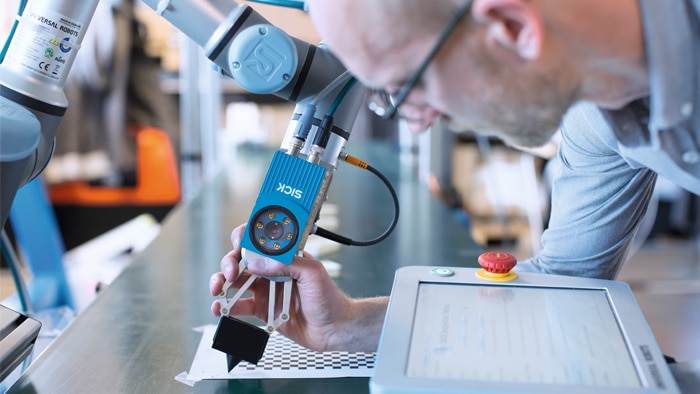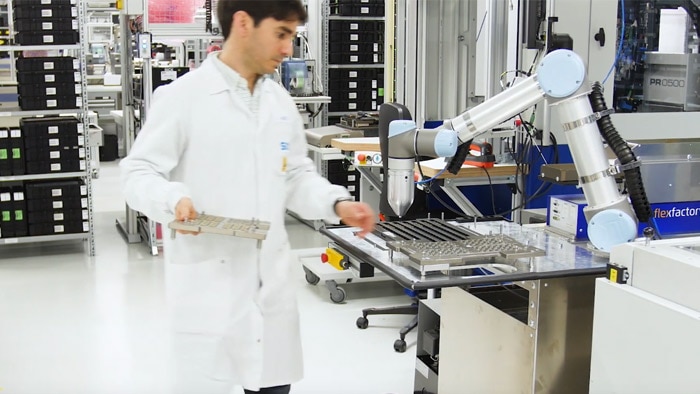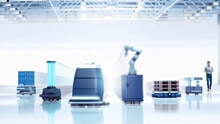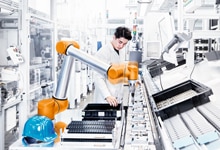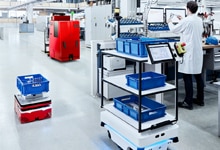The ongoing development of small, powerful and flexibly positionable robots that can collaborate with humans is progressing in leaps and bounds. The sensors from SICK are an important component in this. Sensor intelligence plays a vital role not only in orienting and positioning mobile cobots but also in reliably monitoring their surroundings. Lightweight cobots that are transported to their working position on automated guided vehicles and autonomously position themselves are the newest development in this area. These cobots are making fence-free and flexible work an increasingly standard feature in robotics and a new foundation for functional automation.
The new mobility: How sensors control the cobots of the future
Gone are the days when the majority of industrial robot applications where robots coexist with humans incorporated fixed guards. Smaller and more flexible systems now make them suitable for a wider variety of applications. Mobile cobots mounted on automated guided vehicle systems and weighing no more than approx. 15 kilograms are garnering particular interest. SICK’s complete range of sensor solutions for robots and mobile platforms are being employed in this area: robot vision, safe robotics, end-of-arm tooling, position feedback, environment perception, and safety.
Cobot and mobile platform unite
The advantages of collaborative robots are readily apparent. They are especially suitable for flexible applications that can also be temporarily employed in production lines. The cobots are either permanently integrated into the production line or, more recently, installed on mobile platforms. This provides a further boost to productivity because it drastically reduces the time required to set up the cobots at their workstation. How is this achieved? By employing the sensor solutions from SICK to move the cobot to its workstation and to reliably position it. The cobot is combined with an automated guided vehicle system to create a mobile unit that can autonomously find its safe position and independently carry out any necessary base corrections with the aid of a robot guidance system. Robot guidance systems such as the PLR, or any of the other robot vision systems from SICK, are especially suited for this task.
As they move into position, these mobile platforms with cobots must pose no risk to persons or machines, and sometimes need to travel through narrow passageways in production. Sensor and system solutions from SICK help to reliably protect humans and property from collisions, while at the same time collecting all necessary data for the dependable and flexible navigation of automated guided vehicles. These vehicles manage high speeds even when going around curves thanks to the switching of protective fields.
Collaboration begins in the community
A cobot solution can be implemented efficiently by utilizing the so-called Robot Operating System (ROS). ROS is an open source framework that was developed in a university setting. Thanks to a very active community, it has also found its way into industrial applications around the world in recent years. Here, too, SICK is in step with the times and working on an equal footing with its partners to bring the cobots to life with the help of ROS. Small and mid-sized companies, in particular, can benefit from this because it enables them to save on development costs and resources.
Robots without fences, sensors without limits
Cobots generally have a high level of movement flexibility on account of their degrees of freedom. A wide range of sensor solutions are therefore required to protect their entire working space when in use. SICK’s broad portfolio offers solutions for all aspects of this application. Laser scanners not only guarantee the reliable positioning of the cobots in the workspace but also protect the workers nearby. This includes monitoring the surroundings using safety laser scanners, which reduce the speed of the cobot when a person approaches. An automated restart after a complete stop that requires no manual intervention from the worker is also part of the solution. Furthermore, the motor feedback systems integrated into the cobot reliably and dependably report the position of the robot arms to the controller. This data enables the entire Cartesian workspace right through to the end-of-arm tooling to be securely monitored.
The last mile firmly in view
Similar to the field of logistics, the field of robotics also uses the concept of the “last mile”. The logistics experts are referring to the final, fully-automated steps in delivering the goods to the customer. In robotics, “the last mile” describes the great challenge of ensuring that a deployed robot operates in a safe manner and can be controlled right down to the last millimeter. In particular in the case of precisely calibrated robots working in an open space with no protective fences, meeting this challenge calls for great mastery and sophistication. It is the interplay of a large number of sensors, especially the motor feedback systems, that allows safe and trouble-free end-of-arm tooling on the gripper. New solutions at the end of the arm for completely eliminating injuries to worker’s hands will be available soon. These will employ 2D and 3D image-based robot vision solutions, i.e. a type of “Cobot Vision”, proving that SICK has the last mile in robotics firmly in view.
Sensor solutions for Robotics and mobile platforms:
Working together as equals - Sensor solutions for Robotics
Industry 4.0 is picking up speed: Sensor solutions for mobile vehicles and carts
Josef Zimmermann
Technical Industry Manager Robotics
Josef Zimmermann, como Technical Industry Manager, viene dedicándose intensamente desde 2010 al tema de la robótica. En el año 2000 se incorporó a SICK como ingeniero de aplicaciones en el sector de la tecnología de medición láser y en las tecnologías en red. Comenzó a trabajar en su actual campo de actividad de manera temprana de la mano de la navegación de vehículos autónomos y de proyectos de robótica industrial y de servicios.
Robots móviles:
hacia nuevas dimensiones
La robótica se abre paso, ya sea en la producción, la logística o los servicios. Soluciones de sensores para todas las variantes de robots móviles
Colaboración de igual a igual
Ya se trate de Robot Vision, Safe Robotics, End-of-Arm Tooling o Position Feedback: los sensores SICK permiten a los robots percibir con mayor precisión.
Más información
La industria 4.0 gana velocidad: soluciones de sensores para plataformas móviles
Nuestra gama de soluciones modulares para plataformas móviles permite hacer realidad fácilmente el guiado por carriles, la navegación, el posicionamiento, el reconocimiento del entorno, la seguridad y la manipulación de cargas.

